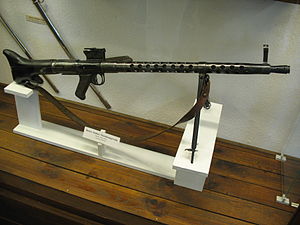MG30
| MG 30 | |
|---|---|

The MG 30 on display in Austria.
(Festung Hohensalzburg) |
|
| Type | Machine gun |
| Place of origin | Switzerland, Austria |
| Service history | |
| In service | 1930s–1940s |
| Used by | See Users |
| Wars | World War II |
| Production history | |
| Designer | Louis Stange |
| Manufacturer | Steyr-Werke AG |
| Variants | MG 15, MG 17 (Both used in aircraft) |
| Specifications | |
| Weight | 12 kg (26 lb) |
|
|
|
| Cartridge | 7.92×57mm Mauser, 8×56mmR, 7×57mm Mauser |
| Action | Recoil |
| Rate of fire | 600–800 RPM |
| Muzzle velocity | 807.92 m/s (2,650 ft/s) |
| Feed system | 30-Round magazine, 25-Round magazine (8×56mmR) |
The Maschinengewehr 30, or MG 30 was a German-designed machine gun that saw some service with various armed forces in the 1930s. It was also modified to become the standard German aircraft gun as the MG 15 and MG 17. It is most notable as the design pattern that led to the MG 34 and MG 42, and thus is one of the major ancestors of many of the weapons in service which would later find widespread use into the 21st century.
Development of the MG 30 took place under the direction of Louis Stange at Rheinmetall's Sömmerda office. However actual production of machine guns was prohibited in Germany under the Versailles Treaty, and the design was rejected by the Reichswehr. Rheinmetall then turned to other companies and licensed the design to Solothurn in Switzerland and Steyr-Daimler-Puch in Austria. Production soon followed, entering the armed forces of both countries as the Solothurn S2-200 and Maschinengewehr Solothurn 1930, or MG 30, respectively. 2000–3000 were also purchased by Hungary, where it was known as the Solothurn 31.M Golyószóró.
The gun is an air-cooled, recoil-operated design, firing standard 7.92×57mm Mauser ammunition, fed from a slightly curved 30-round magazine inserted in the left side of the weapon. It uses a locking ring, which is located at the end of the barrel extension, to lock the bolt. Inside the locking ring, there are six sets of locking lugs, arranged as an interrupted thread, which mate with lugs cut at the rear of the bolt. Rotation of the ring, which locks and unlocks the bolt, is controlled by rollers mounted on the outside of the ring. Upon recoil, these rollers follow cam tracks cut into the receiver. The gun is of relatively simple design, with most parts having a round cross-section. The tubular receiver is an extension of the barrel jacket. The butt hosts a tube which contains the return spring and its guide.
The MG 30 fired both in semi-automatic and full automatic mode depending on how far the two-stage trigger is pulled, with a rate of fire between 600 and 800 rounds per minute in full-auto. It included a folding bipod attached two-thirds down the barrel.
...
Wikipedia
